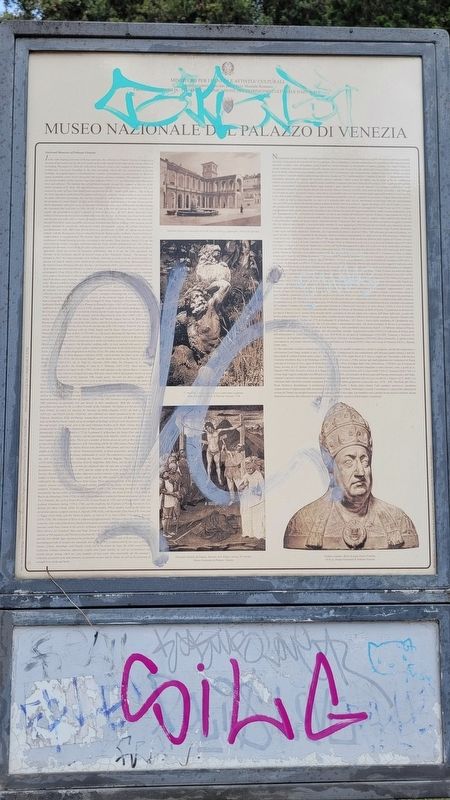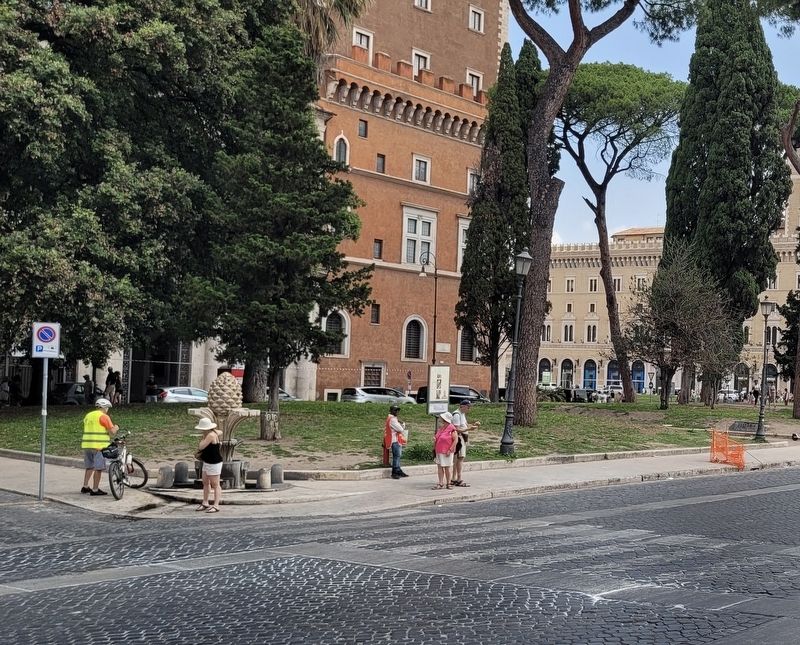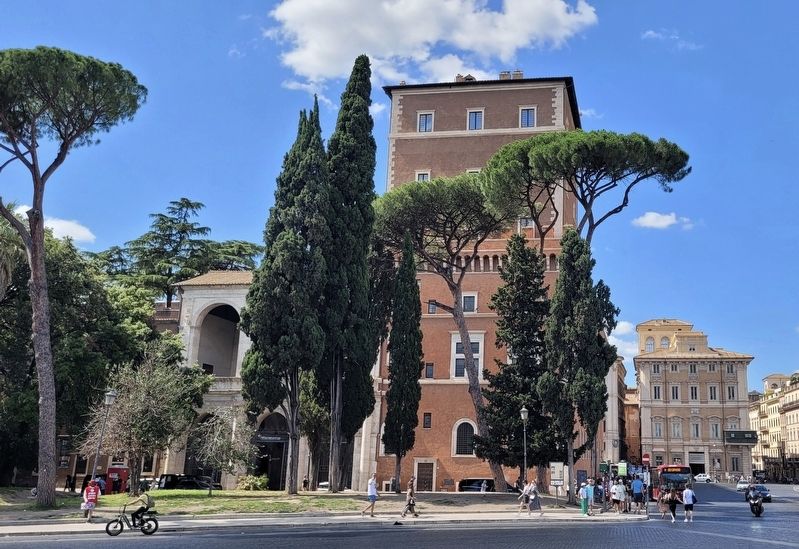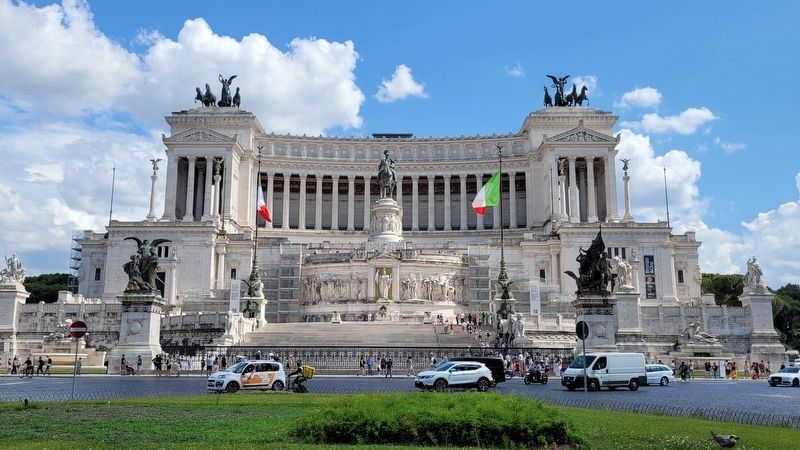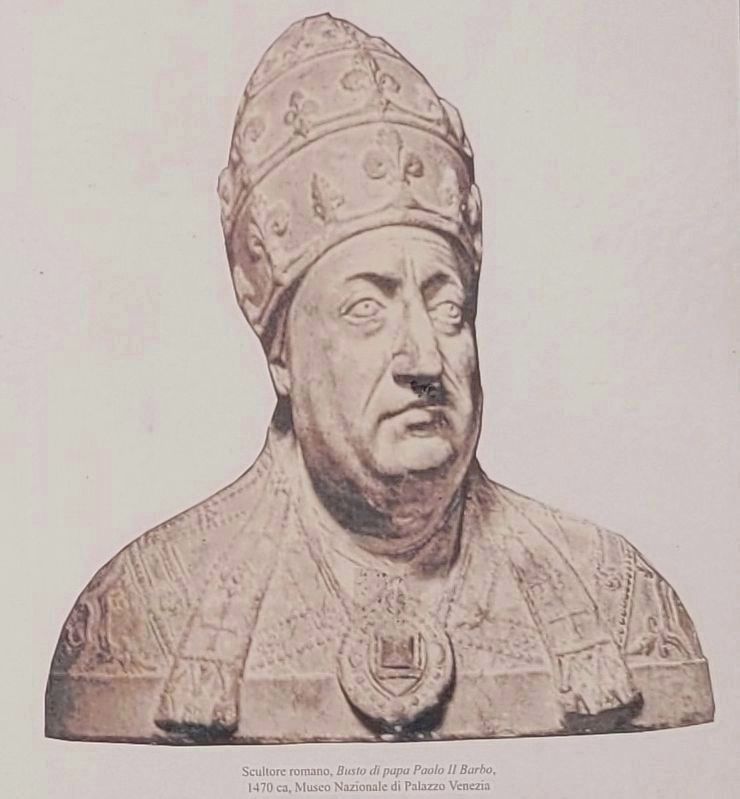Rione IX Pigna in Roma in Città metropolitana di Roma Capitale, Latium, Rome, Italy — Central Italy (Tyrrhenian Coast)
Museo Nazionale del Palazzo di Venezia / National Museum of Palazzo Venezia
Inscription.
Barbo, destinate a mostre temporanee), ovvero l'Appartamento Cybo, il Corridoio dei Cardinali, e tutte le sale storiche del "Palazzetto Venezia". Il Museo fu fondato nel 1921, il nucleo originario del suo patrimonio è costituito da opere provenienti dalla Galleria Nazionale d'Arte Antica, da Castel S. Angelo, dalle collezioni del Museo del Collegio Romano fondato dal gesuita tedesco Athanasius Kircher. Kircher, vissuto nel 1600, non fu solo un instancabile collezionista di oggetti d'arte e curiosità, ma anche uno studioso di respiro e interessi enciclopedici e un conoscitore di antichità. Dal 1924 al 1926 furono aggiunti una serie di arredi sacri e si arricchì ulteriormente la collezione del museo grazie a donazioni, lasciti e confische che comprendevano arredi e suppellettili sacre, argenti, ceramiche e oggetti di oreficeria, tutti di grandissimo valore. Nei quartieri più antichi del palazzo si è svolta la prima mostra di dipinti e arredi del '400 e del '500. L'intento del curatore F. Hermanin, allora direttore del museo, era quello di ricreare l'atmosfera di un'elegante e sontuosa residenza rinascimentale. Il patrimonio pittorico su tavola della Pinacoteca, disposto cronologicamente dal 1200 al 1700 secondo le diverse scuole, comprende la produzione pittorica di molte regioni italiane. Rappresentativi del Veneto sono il Coro degli Angeli di Paolo Veneziano (1333/38 - prima del
1362), la Madonna in trono e la Testa di donna di Pisanello (prima del 1395-1455) e il Cristo e l'adultera di Nicolò de Barbari (circa 1516). Tra le opere provenienti dall'Emilia Romagna si segnalano la Crocifissione di un artista attivo sia in Emilia che in Veneto e identificabile in Stefano da Ferrara (prima metà del XV secolo), e la Deposizione di Lelio Orsi (1508?-1587). In mostra anche dipinti su tavola del Lazio, dell'Umbria e delle Marche come il Redentore di pittore romano, databile alla fine del XIII secolo, e il Crocifisso proveniente dalla chiesa di S. Tommaso ai Cenci, originariamente eseguito per l'Aracoeli. nell'ultimo decennio del XIII secolo. Tra le opere di artisti toscani ricordiamo la Madonna in trono col Bambino, gli angeli e i santi Giuliano e Caterina del pittore fiorentino Lorenzo di Bicci (1370-1405 ca.), la tavola raffigurante la Madonna e Santi di Mariotto di Cristofano (1393-1457), e il Redentore, frammento di un affresco di Benozzo Gozzoli (1421-1497). La Sala Altoviti contiene preziose opere di oreficeria come la Croce in cristallo di età ottoniana (X secolo); il cofano nuziale bizantino, in avorio, dipinto con storie di David; e il reliquiario trecentesco in rame dorato, smalto e cristallo realizzato dall'artista senese Jacopo Tondi per conservare un frammento ligneo della Vera Croce. Il nucleo più antico di dipinti ad olio su tela è costituito dalla
collezione Ruffo di Motto Bagnara (1919), che comprende la Danza delle Ninfe di Donato Creti (1613-1678), il David e Abigail e il Mosè salvato dalle acque di Giuseppe Maria. Crespi (1665-1747), il San Pietro del Guercino (1591-1666), la Cleopatra di C. Maratta (1625-1713) e, inoltre, le Nozze di Cana di F. Solimena (1657-1747), che rispecchia la sontuosa atmosfera della Napoli del '700. Nel salone attiguo alla Sala Altoviti è conservata oggi (2005) una rara raccolta di disegni a pastello che testimoniano sia l'interesse popolare per la vita di corte, sia la popolarità di questo pregiato genere settecentesco. Non solo esistono esempi di ritrattistica "rappresentativa" o più formale come il Ritratto di Maria Leczczynska, sposa di Luigi XV, e la Donna con bambino in abiti turchi di artista della cerchia di Liotard, ma esistono anche ritratti più intimi adatti al gusto borghese come la Ragazza con fiori o la Giovane donna con cagnolino, oltre a pastelli che rivelano una raffinata introspezione psicologica come il Ritratto di Mr. Kinchant in costume da caccia. Uno dei beni più rari e affascinanti del patrimonio museale è la collezione di ceramiche (dal XV al XVIII secolo) e di porcellane (dal XVIII al XX secolo), eccezionalmente ricca e diversificata nella loro manifattura. Sia le ceramiche che le porcellane sono conservate nel cosiddetto Corridoio dei Cardinali. Sono esposti i piatti
decorati provenienti da Urbino, sui quali sono raffigurati il Sacrificio di Attilio Regolo (1535), il Toro di Falaride (1545-55) e Orazio Coclite (1540-45); sono esposti anche oggetti prodotti dalle botteghe di Valencia, Montelupo, Delft e Deruta. Tra questi manufatti ricchi e variegati, spicca il Bacino con lo stemma della Famiglia Barbo, esempio dell'ampio ciclo di opere che anticamente decoravano l'altana della torre, accanto alla basilica paleocristiana di San Marco. Tra le porcellane prodotte dalle più famose Manifatture del Settecento europeo, ricordiamo i biscotti della Reale Manifattura di Napoli, fondata nel 1772 da Ferdinando IV di Borbone, i Santi Pietro e Andrea di Capodimonte (metà XVIII secolo), e i porcellane di Meissen, che sono le più antiche e numerose delle porcellane. Sono presenti numerosi pezzi di Sèvres e porcellane russe prodotte dalla Manifattura Imperiale di San Pietroburgo e dalla Manifattura Popoff del XIX secolo. Sono presenti anche esemplari di ceramica italiana di Doccia del XIX secolo e di ceramica Cozzi della metà del XVIII secolo, oltre a porcellane orientali. Una recente acquisizione, risalente al 1963, è la collezione di bronzi, dono dell'ex Ambasciatore G. Auriti. La collezione è composta da opere dal XVI al XVII secolo, tra cui il Viandante e il Suonatore di cornamusa del Giambologna (1529-1608), tavole con Storie di Ovidio di Guglielmo della
Porta e il Busto di donna di Dusquenoy (1597- 1643). In questa sezione sono esposti anche i rari corredi di calchi rinvenuti nelle fondamenta di Palazzo Venezia nel 1876, e i rilievi del Ritratto di papa Clemente X di Gian Lorenzo Bernini (1598-1680). Un'altra importante sezione è costituita dagli studi preparatori e dai modelli in terracotta, e anche in cartapesta, dal XVI secolo alla fine del XVIII secolo raccolti dal compositore e amante dell'arte Evan Gorga. Questi rari pezzi testimoniano la complessità del processo creativo e la qualità stilistica davvero elevata delle opere di numerosi noti scultori. Ne sono un esempio le tavole di J. Sansovino (1486-1570), raffiguranti Storie di San Marco ed eseguite per i bassorilievi dell'omonima basilica di Venezia; la Testa di Cristo (1506 circa) di Baccio da Montelupo (1469-1535); così come gli studi preparatori per monumenti romani come la Fontana di Trevi, opera di Pietro Bracci che realizzò l'Oceano nel 1759, e di Filippo della Valle che scolpì l'Abbondanza tra il 1759 e il 1760; e il modello per la Fontana di Piazza Navona di G.L Bernini (Testa di moro, 1654). Ancora altri modelli in terracotta, in numero di 100, testimoniano il talento e l'arte di altri celebri scultori come A. Algardi (1598-1654), con il modello della sua Testa di San Paolo, e A. Raggi (1624-1686) con il suo Cristo nel Limbo, nonché P. Le Gros (1666-1719) e C. Rusconi (1658-1728). La collettaon of Silver è composta da circa 800 pezzi dal XVI al XIX secolo, con opere provenienti da diversi paesi del Nord Europa e dall'Italia. Reliquiari e altre opere preziose testimoniano l'abilità artistica degli argentieri romani del 1700, come esemplificato dal Servizio d'Argento per Messa Pontificia e dalla Zuppiera di V. Belli. La Collezione di Porcellane Orientali è composta da 400 opere giapponesi e cinesi dal XVII al XIX secolo. La maiolica dell'Alto e Basso Medioevo documenta la produzione di Orvieto, Viterbo e della stessa Roma, mentre i periodi successivi dell'arte ceramica, soprattutto quella del '500, sono rappresentati dalle ceramiche di Deruta, Pesaro, Urbino, Montelupo e Castelli. Infine, ma non meno importante, la ricca e variegata Collezione Tessile comprende numerosi arazzi, tappeti e tessuti copti, oltre a pezzi ecclesiastici e profani, tra cui rari esempi di merletti. Degni di nota sono anche la collezione di armi e armature antiche del museo, la sezione di mobili e cassapanche, nonché la collezione di ferri battuti e serrature.
Didascalie
Anonimo francese, veduta del cortile di Palazzo Venezia, acquerello, 1850 (coll privata)
C. Monaldi, Venezia sposa il mare, particolare scultoreo della fontana del cortile di Palazzo Venezia, 1730
Giovanni Antonio da Pesaro, Martirio di S. Biagio, tavola, XV secolo, Museo Nazionale di Palazzo Venezia
Scultore romano, Busto di papa Paolo II Barbo, 1470 ca, Museo Nazionale di Palazzo Venezia
In the wide-ranging panorama of Roman museums, the collection at Palazzo Venezia is unique as a museum of decorative arts for the rich variety of its works and the great value of the artistic objects in its holding. The palace in which the collection is housed is itself a rare example of Renaissance urban architecture, conceived according to the then prevailing criteria for the construction of private buildings. Its original aspect is documented by a number of medallions: a castle-fortress of Medieval aspect, framed by corner towers decorated with merlons and lancet windows. The museum is located in the ancient residence of the Venetian Pope Paul II Barbo (1464-1471), an enthusiastic and cultural art lover and collector. The building then served uninterruptedly through the centuries as the seat of the tinalar Cardinals of St. Mark. The adjacent homonymous early-Christian basilica, founded in 336, was restored by order of Pope Paul himself and transformed into the "chapel of the palace". The rooms of the Cybo Apartment, embellished throughout with frescoes depicting classical subjects and containing the entire collection of paintings, has not been subjected to radical changes through the centuries with the exception of a small chapel. All other areas of the museum, instead, such as the State Room and the Barbo Aparment, which now serve as exposition and museum space, were substantially modified during the renovation that took place in 1916. Worthy of note is the fact that during the years of the Fascist regime, the government occupied a number of halls of the palace. In 1929, Benito Mussolini chose Palazzo Venezia on his Seat of Government: following this decision, the museum was closed to the public and became accessible only to visitors granted permission from the Police. Following the end of the Second World War, numerous public and private donations enriched the holdings of the museum and the palace assumed its present-day multi-genre artistic physiognomy. Among the ceilings decorated in neo-Renaissance style, that of the Altoviti Room is a special case: in 1888, the ceiling was decorated entirely with the Renaissance frescoes detached from the Roman palace of Bindo Altoviti at Piazza S. Angelo before it was demolished. The frescoes depict scenes of rural life related to Ceres, and to the celebration of human farming activities according to the months. These frescoes, dated 1553, are the work of Giorgio Vasari, who drew inspiration from the Twelve Months of Hannibal Caro. The works are displayed in the many rooms on the first floor of the palace (with the exception of the rooms of the Barbo Apartment, which are devoted to temporary exhibitions), that is to say, the Cybo Apartment, the Corridor of the Cardinals, and all the historic rooms of the "Palazzetto Venezia". The museum was founded in 1921, the original nucleus of its holdings consisting of works from the National Gallery of Ancient Art, from S. Angelo Castle, from the collections of the Roman College Museum founded by the German Jesuit Athanasius Kircher. Kircher, who lived in the 1600's, was not only a tireless collector of art objects and curiosities but also a scholar of encyclopaedic scope and interests and a connoisseur of antiquities. From 1924 to 1926, a series of church furnishings was added and further additions were made the museum's collection thanks to donations, bequests and confiscations which included church furniture and ornaments, sets of silver, ceramics, and objects of jewellery, all of the greatest value. The first exhibition displaying paintings and furnishings of the 1400's and the 1500's took place in the oldest quarters of the palace. The intention of its curator F. Hermanin, at the time the director of the museum, was to recreate the atmosphere of an elegant and sumptuous Renaissance residence. The collection of panel paintings in the Picture Gallery, arranged chronologically from the 1200's to the 1700's according to the various schools, consists in the pictorial output of many Italian regions. Representing the Veneto region are the Choir of Angels by Paolo Veneziano (1333/38 - before 1362), the Enthroned Madonna and the Head of a Woman by Pisanello (before 1395-1455) and the Christ and the Adulteress by Nicolò de Barbari (circa 1516). Among the works from the Emilia Romagna region are the Crucifixion by an artist active in both the Emilia and the Veneto regions and identifiable as Stefano from Ferrara (first half of the 15th century), and the Deposition by Lelio Orsi (1508?-1587). Also on display are panel paintings from the Lazio, Umbria and Marche regions such as the Redeemer by a Roman painter, dating to the end of the 13th century, and the Crucifix from the Church of S. Tommaso ai Cenci, originally done for the Aracoeli in the last decade of the 13th century. Works by Tuscan artists include the Enthroned Madonna with the Child, Angels and the Saints Julian and Catherine by the Florentine painter Lorenzo di Bicci (1370-1405 ca.), the panel depicting the Madonna and Saints by Mariotto di Cristofano (1393-1457), and the Redeemer, a fragment from a fresco by Benozzo Gozzoli (1421-1497). The Altoviti Room contains precious works of jewellery such as the crystal Cross from the Othonian period (10th century); the Byzantine wedding coffer, in ivory, painted with stories of David; and the 14th century reliquary in gilt copper, enamel and crystal made by the Siena-born artist, Jacopo Tondi, to preserve a wooden fragment from the True Cross. The oldest nucleus of oil paintings on canvas consists of the Ruffo di Motto Bagnara collection (1919), which includes the Dance of the Nymphs by Donato Creti (1613-1678), the David and Abigail and the Moses Saved from the Waters by Giuseppe Maria Crespi (1665-1747), the St. Peter by Guercino (1591-1666), the Cleopatra by C. Maratta (1625-1713) and, further, the Wedding at Cana by F. Solimena (1657-1747), which mirrors the sumptuous atmosphere of Naples in the 1700's. In the hall adjacent to the Altoviti Room is conserved today (2005) a rare collection of pastel drawings that bear witness both to the popular interest in court life and to the popularity of this exquisite 18th century genre. Not only are there examples of the "representative" or more formal portraiture such as the Portrait of Maria Leczczynska, the spouse of Louis XV, and the Woman and Child Dressed in Turkish Attire by an artist in the circle of Liotard, but there are also more intimate portraits suited to the middle-class taste such us the Girl with Flowers or the Young Woman with a Small Dog, as well as pastels that reveal a refined psychological introspection such as the Portrait of Mr. Kinchant in Hunting Costume. One of the most rare and fascinating of the museum holdings is the collection of ceramics (15th to the 18th centuries), and porcelains (18th to the 20th centuries), exceptionally rich and diverse in their manufacture. Both the ceramics and the porcelains are housed in the so-called Corridor of the Cardinals. On display are the decorated plates from Urbino, on which are depicted the Sacrifice of Attilius Regulus (1535), the Bull of Phalaris (1545-55), and Orazio Coclite (1540-45); also exhibited are objects produced by the workshops of Valencia, Montelupo, Delft, and Deruta. Among these rich and varied wares, the Basin with the coat of arms of the Barbo Family stands out as an example of the large series of works that formerly decorated the roof terrace of the tower, next to the early-Christian basilica of St. Mark. Among the porcelains produced by the most famous Manufactures of 18th century Europe, are the biscuits made by the Royal Manufacture of Naples, founded in 1772 by Ferdinand IV of Bourbon, the Saints Peter and Andrew of Capodimonte ware (mid 18th century), and the porcelains from Meissen, which are the oldest and the most numerous of the porcelains. There are a number of Sevres pieces as well as Russian porcelains produced by the Imperial Manufacture of St. Petersburg and by the 19th century Popoff Manufacture. There are also examples of the Italian Doccia ware from the 19th century and Cozzi ware dating to the middle of the 18th century, as well as Oriental porcelains. A recent acquisition, dating to 1963, is the collection of bronzes, gift of the former Ambassador G. Auriti. The collection is composed of works from the 16th to the 17th centuries, including the Wayfarer and the Bagpipe Player by Giambologna (1529-1608), plaques with Stories from Ovid by Guglielmo della Porta, and the Bust of a Woman by Dusquenoy (1597-1643). In this section are displayed also the rare sets of moulds discovered in the foundations of Palazzo Venezia in 1876, and the reliefs of the Portrait of Pope Clement X by Gian Lorenzo Bernini (1598-1680). Another important section consists of the preparatory studies and the models in terracotta, and even in papier-mache, from the 16th century to the end of the 18th century collected by the composer and art lover Evan Gorga. These rare pieces testify to the complexity of the creative process and to the truly elevated stylistic quality of the works of numerous well-known sculptors. Examples are the plaques of J. Sansovino (1486-1570), illustrating Stories of St Mark and executed for the bas-reliefs of the homonymous basilica in Venice; the Head of Christ (circa 1506) by Baccio da Montelupo (1469-1535); as well as the preparatory studies for Roman monuments such as the Trevi Fountain, the work of Pietro Bracci who created Ocean in 1759, and of Filippo della Valle who sculpted Abundance during 1759 to 1760; and the model for the Fountain of Piazza Navona by G.L Bernini (the Moor's Head, 1654). Yet other terracotta models, 100 in number, testify to the talent and art of other famous sculptors such as A. Algardi (1598-1654), with the model of his Head of St. Paul, and A. Raggi (1624-1686) with his Christ in Limbo, as well as P. Le Gros (1666-1719) and C. Rusconi (1658-1728). The collection of Silver is composed of approximately 800 pieces from the 16th to the 19th centuries, with works from diverse Northern European countries and from Italy. Reliquaries and other precious works bear witness to the artistry of Roman silversmiths of the 1700's, as exemplified by the Silver Service for Pontifical Mass and Soup Tureen by V. Belli. The Oriental Porcelain Collection consists of 400 Japanese and Chinese works from the 17th to the 19th centuries. Majolica from the Early and the Late Middle Ages document the production of Orvieto, Viterbo and of Rome itself, while the succeeding periods of ceramic art, especially that of the 1500's, is represented by the ware of Deruta, Pesaro, Urbino, Montelupo, and Castelli. Lastly, but by no means the least, the richly varied Textile Collection includes numerous tapestries, carpets and Coptic textiles, as well as ecclesiastical and secular pieces, among which are rare examples of lace work. Also noteworthy are the museum's collection of ancient arms and armours, its furniture section and its chests, as well as its collection of wrought iron works and locks.
Captions
Anonymous French, View of the courtyard of Palazzo Venezia, watercolor, 1850 (private collection)
C. Monaldi, Venice marries the Sea, sculptural detail of the fountain in the courtyard of Palazzo Venezia, 1730
Giovanni Antonio da Pesaro, Martyrdom of St. Blaise, panel, 15th century, National Museum of Palazzo Venezia
Roman sculptor, Bust of Pope Paul II Barbo, ca. 1470, National Museum of Palazzo Venezia
Erected by Ministero per i Beni e le Attivita' Culturali, Soprintendenza Speciale per il Polo Museale Romano, Progetto Mirabilia - Piano di Comunicazione del Patrimonio Culturale Nazionale.
Topics. This historical marker is listed in these topic lists: Anthropology & Archaeology • Architecture • Arts, Letters, Music. A significant historical year for this entry is 1916.
Location. 41° 53.723′ N, 12° 28.897′ E. Marker is in Roma, Lazio (Latium, Rome), in Città metropolitana di Roma Capitale. It is in Rione IX Pigna. Marker is at the intersection of Piazza di San Marco and Via del Teatro di Marcello, on the right when traveling west on Piazza di San Marco. The marker is located northwest of the Monument to Victor Emmanuel II along the street. Touch for map. Marker is at or near this postal address: Piazza di S Marco 32, Roma, Lazio 00186, Italy. Touch for directions.
Other nearby markers. At least 8 other markers are within walking distance of this marker. A different marker also named Museo Nazionale del Palazzo di Venezia / National Museum of Palazzo Venezia (within shouting distance of this marker); Vittoriano (within shouting distance of this marker); Vittorio Emanuele II (within shouting distance of this marker); a different marker also named Vittoriano (about 120 meters away, measured in a direct line); Auditoria di Adriano / Hadrian's Auditoria (about 120 meters away); Insula dell'Ara Coeli (about 150 meters away); a different marker also named Auditoria di Adriano / Hadrian's Auditoria (about 150 meters away); Italian government officially recognized Czech-Slovakia (about 180 meters away). Touch for a list and map of all markers in Roma.
More about this marker. The Italian text was translated with Google Translate from the English text due to the small fonts size on the marker and the low quality on the closeup photograph of the marker.
There are several duplicate markers around the National Museum of Palazzo Venezia and the Monument to Victor Emanuele II Monument.
Also see . . . Palazzo Venezia. Rome Museum (Submitted on December 18, 2023, by James Hulse of Medina, Texas.)
Credits. This page was last revised on December 18, 2023. It was originally submitted on December 18, 2023, by James Hulse of Medina, Texas. This page has been viewed 108 times since then and 76 times this year. Photos: 1, 2, 3, 4, 5. submitted on December 18, 2023, by James Hulse of Medina, Texas.
Editor’s want-list for this marker. Clear readable closeup photo of the marker • Can you help?
